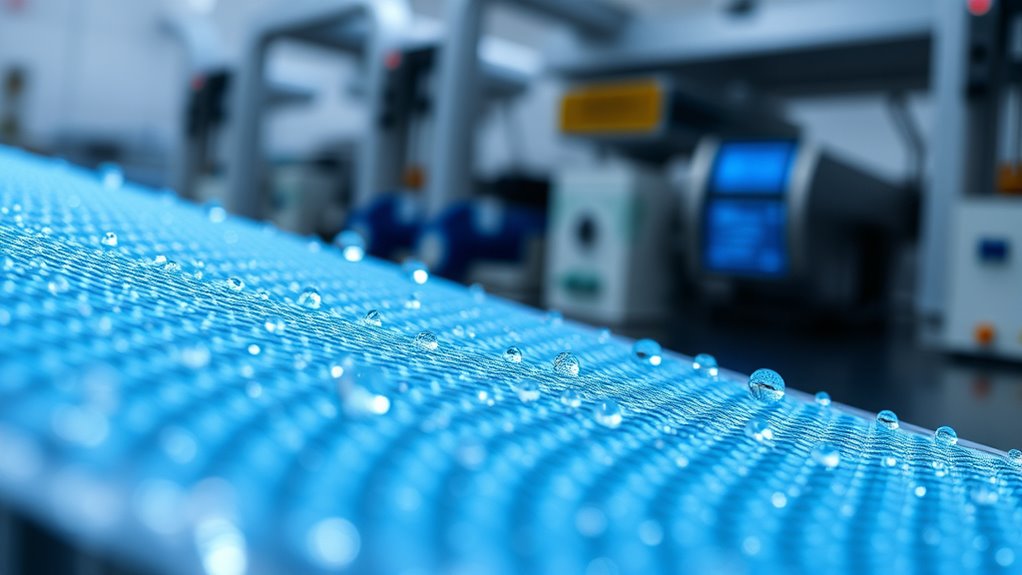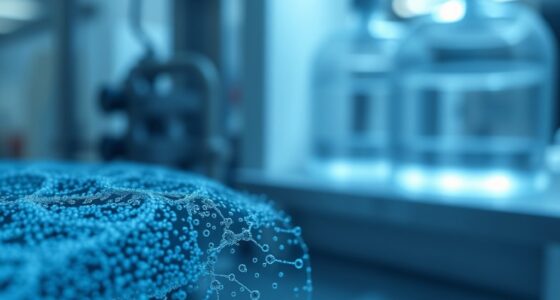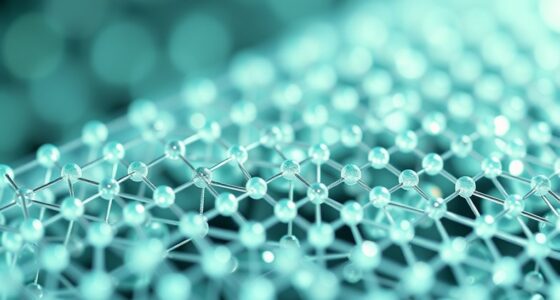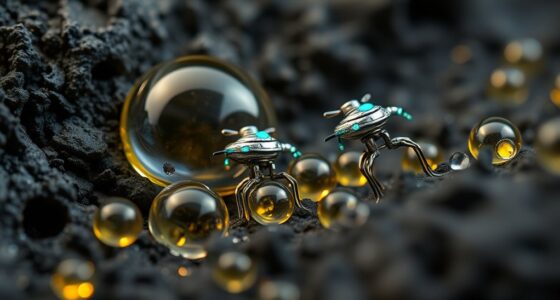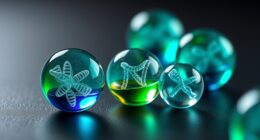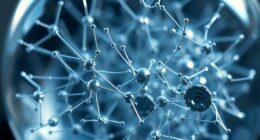Nanotech improves water desalination by creating advanced membranes that are more efficient, durable, and resistant to fouling. These nanomaterial-integrated membranes allow water to flow faster while reducing energy use and prolonging lifespan. They also help prevent issues like membrane clogging and biofouling. By harnessing nanotechnology, you can achieve better, more sustainable water purification solutions. If you want to understand how these innovations are transforming desalination, there’s much more to explore.
Key Takeaways
- Nanotechnology enhances desalination membranes by increasing permeability and reducing energy consumption.
- Embedding antimicrobial nanoparticles prevents biofouling, extending membrane lifespan.
- Nanomaterials improve membrane durability, resistance to clogging, and overall efficiency.
- Nanotech-enabled membranes better remove salts and contaminants, ensuring cleaner drinking water.
- Advanced nanomaterials support scalable, cost-effective, and sustainable desalination solutions worldwide.
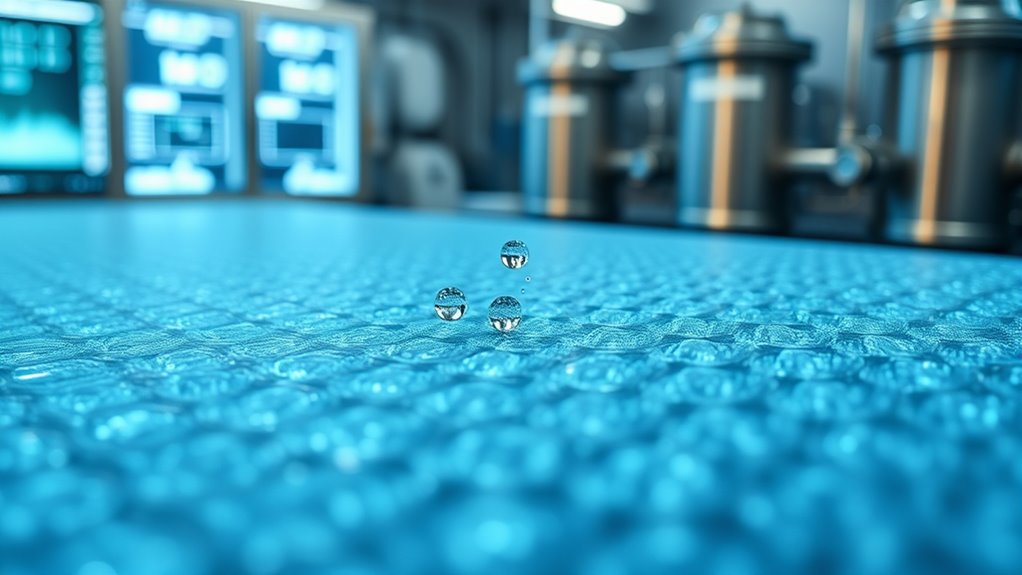
Have you ever wondered how nanotechnology is transforming water desalination? It’s an exciting frontier where tiny innovations make a big difference. At the heart of this revolution are advancements in membrane efficiency and nanoparticle development. Traditional desalination processes, like reverse osmosis, rely on membranes to filter out salt and impurities, but these membranes often face challenges like clogging and limited lifespan. Nanotech offers a way to overcome these hurdles by enhancing membrane performance at a microscopic level. By integrating nanomaterials into membranes, engineers can create surfaces that repel fouling agents, increase permeability, and reduce energy consumption. These nanostructured membranes allow water to pass through more quickly and efficiently, making desalination plants more sustainable and cost-effective.
Nanoparticle development plays a critical role in this progress. Researchers are designing specialized nanoparticles that can be embedded within membrane materials. These nanoparticles can serve multiple functions: improving structural integrity, increasing selectivity, and preventing biofouling. For example, silver or titanium dioxide nanoparticles are often used for their antimicrobial properties, helping keep membranes cleaner longer. Other nanoparticles, like carbon-based nanomaterials, enhance the membrane’s ability to filter out specific contaminants, ensuring purer water. The development of these nanoparticles is a precise science; their size, shape, and surface chemistry are optimized to maximize effectiveness without compromising the membrane’s stability. This level of control allows for the production of next-generation membranes that outperform conventional options, both in terms of durability and filtration capacity.
Additionally, the integration of high-performance nanomaterials into membranes has been shown to significantly boost their resilience and efficiency. You might not realize it, but these innovations translate directly into real-world benefits. Higher membrane efficiency means less energy is needed to push water through the system, which lowers operational costs and reduces environmental impact. Improved nanoparticle development also extends the lifespan of membranes, cutting down on replacement and maintenance expenses. As a result, water desalination becomes more accessible and scalable, especially in regions where freshwater is scarce. These tiny particles and enhanced membranes work together to create a more sustainable solution for the world’s growing water needs. They demonstrate how nanotechnology isn’t just about miniaturization; it’s about reimagining processes to make them faster, cleaner, and more efficient. As research advances, you can expect to see even more innovative nanotech applications transforming how we turn seawater into safe, drinkable water, ensuring a more sustainable future for everyone.
Frequently Asked Questions
What Are the Environmental Impacts of Nanotech Desalination?
You might wonder about the environmental impacts of nanotech desalination, and it’s important to consider its footprint. While it can reduce energy use, it may also cause ecosystem disruption if nanoparticles leak into water systems. This contamination can harm aquatic life and affect water quality. Careful management and advances in nanotech safety are vital to minimizing these risks and ensuring sustainable benefits for the environment.
How Cost-Effective Is Nanotech Compared to Traditional Methods?
You’ll find that nanotech desalination is becoming more cost-effective thanks to recent technological advancements, making it increasingly economically feasible. While traditional methods like reverse osmosis remain cheaper today, nanotech’s potential for reducing energy consumption and improving efficiency could lower costs long-term. As research progresses, you might see nanotech become a more practical alternative, especially in regions where traditional systems are too expensive or inefficient.
Are There Health Risks Associated With Nanomaterials in Water?
Health hazards hover over nanomaterials, raising real concerns about toxicity and safety. You might worry about material toxicity, as tiny particles could potentially seep into water supplies. While research is ongoing, some nanomaterials pose health concerns if ingested or inhaled, possibly causing cellular or systemic issues. It’s essential to monitor, regulate, and mitigate these risks, ensuring that nanotech’s benefits don’t come with unintended health hazards.
How Scalable Are Nanotech Solutions for Global Water Needs?
You might find that nanotech solutions face significant scalability challenges due to manufacturing hurdles. While they show great potential for water desalination, scaling up production to meet global needs remains complex and costly. You’ll need advances in fabrication techniques and cost-effective methods to produce nanomaterials at a large scale. Overcoming these hurdles is essential if nanotech desalination technologies are to become a practical, widespread solution for worldwide water scarcity.
What Regulatory Challenges Exist for Nanotech Desalination Technology?
Exploring the delicate dance of regulatory approval and patent hurdles is your first step in advancing nanotech desalination. You’ll need to address safety concerns, environmental impacts, and quality standards set by authorities, which can slow down innovation. Securing patents might also prove tricky, as intellectual property rights are fiercely protected. Staying proactive with regulators and innovators helps you overcome these challenges and bring effective, sustainable solutions to water-scarce regions.
Conclusion
You now stand at the frontier of a new ocean, where nanotech acts as a lighthouse guiding us toward cleaner, limitless water. With tiny marvels working tirelessly like diligent artisans, we can turn the tide on water scarcity. Embrace this cutting-edge technology, and imagine a world where every droplet is a drop of hope. Together, nanotech can transform our future, making the dream of endless, pure water a vivid reality on the horizon.
